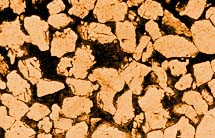There's Oil Down There
 Ever wonder what oil looks like underground, down deep, hundreds or thousands of feet below the surface, buried under millions of tons of rock and dirt? If you could look down an oil well and see oil where Nature created it, you might be surprised. You wouldn't see a big underground lake, as a lot of people think. Oil doesn't exist in deep, black pools. In fact, an underground oil formation - called an 'oil reservoir' - looks very much like any other rock formation. It looks a lot like...well, rock. Oil exists underground as tiny droplets trapped inside the open spaces, called 'pores,' inside rocks. The 'pores' and the oil droplets can be seen only through a microscope. The droplets cling to the rock, like drops of water cling to a window pane.
Ever wonder what oil looks like underground, down deep, hundreds or thousands of feet below the surface, buried under millions of tons of rock and dirt? If you could look down an oil well and see oil where Nature created it, you might be surprised. You wouldn't see a big underground lake, as a lot of people think. Oil doesn't exist in deep, black pools. In fact, an underground oil formation - called an 'oil reservoir' - looks very much like any other rock formation. It looks a lot like...well, rock. Oil exists underground as tiny droplets trapped inside the open spaces, called 'pores,' inside rocks. The 'pores' and the oil droplets can be seen only through a microscope. The droplets cling to the rock, like drops of water cling to a window pane.
How do oil companies break these tiny droplets away from the rock thousands of feet underground? How does this oil move through the dense rock and into wells that take it to the surface? How do the tiny droplets combine into the billions of gallons of oil that the United States and the rest of the world use each day? Imagine trying to force oil through a rock. Can't be done, you say? Actually, it can. In fact, oil droplets can squeeze through the tiny pores of underground rock on their own, pushed by the tremendous pressures that exist deep beneath the surface. How does this happen? Imagine a balloon, blown up to its fullest. The air in the balloon is under pressure. It wants to get out. Stick a pin in the balloon and the air escapes with a bang!
Oil in a reservoir acts something like the air in a balloon. The pressure comes from millions of tons of rock lying on the oil and from the earth's natural heat that builds up in an oil reservoir and expands any gases that may be in the rock. The result is that when an oil well strikes an underground oil reservoir, the natural pressure is released - like the air escaping from a balloon. The pressure forces the oil through the rock and up the well to the surface. If there are fractures in the reservoir -- fractures are tiny cracks in the rock -- the oil squeezes into them. If the fractures run in the right direction toward the oil well, they can act as tiny underground 'pipelines' through which oil flows to a well.
Fact Credit
DOE Department of Energy


